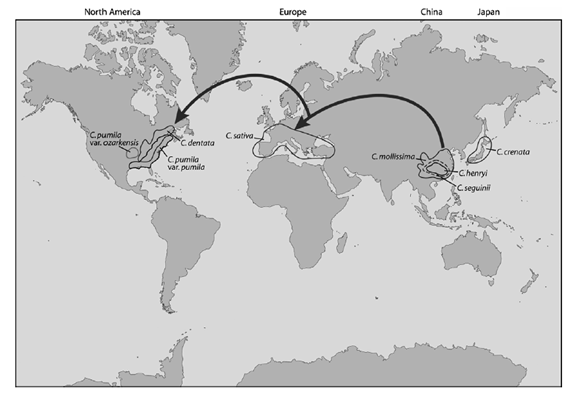The genus Castanea has 24 chromosomes, belongs to the Fagaceae family (Camus, 1929) and includes 12 species.
The chinese chestnut (C. mollissima Blume) and the Japanese chestnut (C. crenata Sieb. And Zucc.) occur in East Asia.
The American chestnut tree (C. dentata Borkhausen) is native to the Eastern part of North America.
C. sativa Mill, the European chestnut, is present in all countries of the Mediterranean Basin.
The species (C. henryi (Skan) Redher and Wilson) is found in limited areas of China, and the species C. pumila Mill. in some areas of America.
The genetic divergence among the five main chestnut species, from East to West, was studied by Lang et al. (2007) using molecular markers. These authors verified that the three Asian species were included in the same group and the evolution of the genus Castanea occurred from East to West, from China, to Europe and finally to North America, which could explain the greater sensitivity of both species, European and American, to the main diseases,

Distribution of the genus Castanea and the hypothesis of migration from West to East, based on information obtained from studies carried out with chloroplast DNA. (Lang et al., 2007)
Origin and domestication of chestnut varieties
The first evidence of chestnut cultivation dates back to the third millennium BC in Eastern Europe (Anatolia Peninsula, Northeast Greece and Southeast Bulgaria). From these zones, first the Greeks and later the Romans spread the culture to the West (Conedera et al., 2004), being chestnut used in the Middle Age for the timber and fruit, the fruits were the basic diet of rural populations in the Mediterranean and Southern European countries.
It is a species of great economic importance, because it is a multiple-use hardwood, which combines the forest and fruit aptitude, having a long time tradition of culture in Europe, mainly in the Mediterranean region. It currently occupies the entire Northern Mediterranean area, from Portugal to Turkey. The species that exists in Portugal is also the one that predominates in Europe, Castanea sativa. There are signs of its existence in the Portuguese territory for many centuries, reason why it is considered as an indigenous species. However some people think that it was introduced to the Iberian Peninsula, probably during the Roman era.
The study of the genetic structure of chestnut stands, evaluated with different genetic markers and different analytical approaches, revealed a significant level of genetic variation for all species of the genus Castanea, identifying five genetic pools in Europe, a great variability in the Iberian Peninsula and a unique genetic pool in Greece (Aravanopoulos et al., 2005, Pereira Lorenzo et al., 2010). The Atlantic regions of France, Spain and Portugal are considered as the most important areas of origin of native species of Castanea sativa Mill. (Conedera et al., 2004; Krebs et al., 2004).
The recent study developed for the Iberian Peninsula varieties with molecular markers revealed that the origin of the current varieties and the process of diversification is a combination of clonal propagation, hybridization and mutations. The clonal propagation, resulting from the common practice of grafting, used for fruit production, contributes with 33% for the stability of the varieties, being the mutations and hybridizations between varieties, the processes that can most contribute to the diversification, (Pereira-Lorenzo et al., 2010). That may explain the high variability of varieties of Iberian Peninsula being Trás-os-Montes region the one that reveals an higher diversity of genotypes. Although the phylogenetic map of the chestnut tree is still not fully understood, the greater genetic similarity observed in the trees of the western part of the Anatolian Peninsula, with the French and Italian populations, suggests that probably the chestnut was introduced by the Greeks in Italy in the same way that the vine was introduced (Villani, 1999).
Distribution area of European Chestnut
The European chestnut covers a total area of 2.53 million hectares, of which 2 million correspond to forests in which it is the dominant species, being the remaining area of 0.53 million, occupied by stands for fruit production (20.9% of the total area of chestnut). Fruit production declined considerably in Europe in the 20th century to 200,000 tonnes (with a reduction of around € 300 million). This decline was mainly due to diseases and changes in the structure of society (Conedera et al., 2004). In Portugal the area was reduced from 80,000 hectares, before the introduction of the Phytophthora cinnamomi in 1838, to the current 34,000 hectares of orchards and 42,000 hectares in total including the wild populations.
The development of the chestnut market, verified in the last decades, confirms the potential of this resource, both for the production of traditional products and also for new products, related with organic and natural foods, allowing to think about an optimistic future for the European chestnut, if the lack of new plant material with improved resistance to the main diseases, mainly root rot is provided. This is a species with a good economic support for the producing regions, especially for the mountainous Mediterranean regions, of scarce economic resources. The chestnut tree is one of the species included in the EUFORGEN (European Forest Genetic Resources Program) program which aims to ensure the effective conservation and sustainable use of forest genetic resources in Europe.
The European chestnut (Castanea sativa Mill.), is an environmentally and economically important species in Europe, for the production of fruit, timber and protection of the landscape. Towards the end of the century, there was a sharp increase in the demand for chestnut trees, which led to triplicate the plantation area and the recovery of old orchards. However, ink disease, caused by pathogens of the genus Phytophthora spp, first referenced in Portugal in 1838, and the blight disease introduced in Europe from the United States, in 1938, accounted for the near total destruction of chestnut forests and orchards in the United States (Bhiragi et al., 1946). In Europe, blight has not been as devastating as in the United States due to the presence of hypovirulent strains that have contributed to its biological control.
In Europe, Castanea sativa is usually cultivated between 400 and 1,000 meters in altitude, depending on the latitude. The lower altitudes are recommended for the higher latitudes and vice versa (Costa, 2005). Early bursting of hybrids (mid-March) restricts their use to altitudes below 500 meters, and in areas with Spring frosts. Chestnut needs a minimum precipitation of 800 mm, being the plants of this species moderately thermophilic and well adapted to ecosystems with an average annual temperature of 8ºC to 15ºC and with average temperatures for 6 months above 10ºC. Chestnut is characterized by being a mesophyll species with some limitations at high temperatures. Calcium rich soils, low pH and poor drainage do not work well for these trees. It usually grows in poor soils in sloping areas but also in volcanic soils (Sicily, Canary Islands, Madeira and Azores). Deep soils and well-developed roots are important to allow the tree to maintain water potential in the hottest months (July to September) (Costa et al., 2005). Chestnut is still also better adapted to slopes with less sun exposure, as are those exposed to the north (Gomes-Laranjo, 2007).




